#or creating something from wholecloth
Explore tagged Tumblr posts
Text
Thank you all so much for the kind words! I appreciate it a lot!

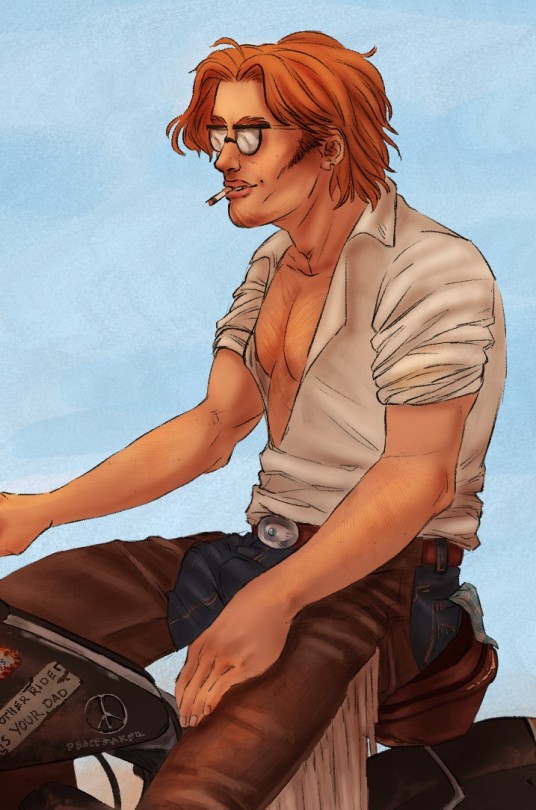
july 5th, 2021 vs july 24th, 2023
bit of an Artist Evolution, but also character evolution. two years of drawing Red! the roots are the same, even if the details have changed.
2 years ago, i was extremely new to digital art and was kind of fumbling my way through photoshop, trying to figure things out as i went. that didnt exactly change, i just got a lot better at fumbling.
then i lost photoshop, had a meltdown, and got CSP. lather, rinse, repeat.
im getting more comfortable working outside my comfort zone. or i guess, expanding that comfort zone. there's still a lot i dont like about my art - and a lot i feel i need to improve on, but i think im getting there, however slowly. im learning and figuring things out, though that never really stops. i look forward to seeing where im at in another two years.
thanks yall for sticking around!
#not fallout#kal talks#been doing art for 13 years but i really do feel like most of my art improvement has been in the last 2.5 years#obviously my traditional art pre digital art was different but with digital i really was starting over from scratch#i had given digital art a try when i was around 14 15 and couldnt get the hang of it#so when we were all forced home for covid and my university gave me photoshop i figured#i might as well use this on my own time#i had the tablet anyway#and slowly i just started doing more and more digital art and less dry media#which i still do do! just usually only in class. i really enjoy life drawing its a lot of fun but god is it hard#not sure what changed but it does feel like a switch flipped in my brain that helped me begin to understand how to reference#images and how to draw what i see#and that's one of the things i dont like about my art ironically - if i dont have a reference im not good at filling in gaps#or creating something from wholecloth#i dont have a great visual imagination believe it or not#i struggle a lot creating something from my brain and have gotten worse since covid#i rely a lot on just memorization of anatomy#which is why things like ourfits#poses and compositions are usually pretty bland#i dont have a great idea of what i want in my head so my idea of how to execute it is pretty minimal#and idk how to change that. i dont think i CAN tbh. i cant get better at imagining stuff#anyways. im not complaining just musing. i thought it was interesting#thank you all again for the kind words! ive really enjoyed my artist's journey#could nwver have imagined this was where id be 2-3 years ago
74 notes
·
View notes
Text
ive got 8 parts to arrange for the youth orchestras now. yess
#the 'yess' is because they pay me $30/hr to arrange#i have 4 c horn and 2 c clarinet parts to transpose which is dead simple#and i have 2 (though possibly more coming) tuba parts to create from wholecloth#they aren't part of the score's instrumentation but we have a tuba player we need to give him something to do#arranging like that takes longer and more work#but it's just a matter of staring at the score and teasing out a line that fits the context of the orchestration.#usually doubling a trombone line most of the way lol#it's time consuming but it's work. and if it pays by the hour i'm okay with time consuming haha#i'm just happy to earn some more#sasha speaks
13 notes
·
View notes
Text
Host talking here, just wanted to say this because, somehow, people are still pushing the Tulpamancy=Tibetan practice myth, and it needs addressing.
Myth/oversimplification: Tulpamancy is, or is based on a Tibetan Buddhist closed practice, therefore tulpamancy is bad because something something cultural appropriation.
Fact: Tulpamancy, or at least the word tulpa, is very loosely inspired by a single chapter in a 1929 book on mysticism in Tibet written by a French Theosophist named Alexandra David Neel, who visited in the 1920s and wrote about a time she supposedly learned about tulpas and even took a crack at creating one (and spending 6 months destroying it after it supposedly became too powerful and turned malicious, hence the tulpa stereotype of the 'imaginary friend turned evil!').

However, there are no contemporary sources, nor sources written by any actual Tibetans or Buddhists (and it's not just a matter of their practices not being written down, you CAN find many texts on esoteric practices of Tibetan Buddhism if you bother to look) to suggest it was an actual practice in those days. David-Neel is generally well-regarded among Buddhists of today for her early look into Tibetan culture, but in the end she is still an outsider looking in.
Most agree that the term as David Neel used it, was most likely a misunderstanding of the term SprulPa, which refers to the earthly bodies that Buddhas manifest as to teach those who have not achieved Nirvana. There might also be a bit of the word Tulku, which refers to individuals who are recognised as the reincarnation of a past teacher, Bodhisattva or other enlightened being (like the Dalai Lama). And yes, there are some Indian Buddhist sources that talk about 'mind-made bodies', but this is less referred to as an ability one can attain with training and practice, and more a power that Buddhas have.
It also holds some vague similarity to the Yidam, a sort of meditational focal point in the form of a Buddha, Bodhisattva or other Tibetan deity or spirit, that the practitioner visualises in vivid detail and then identifies themselves with, in an attempt to internalise their qualities and attributes (wisdom from Manjushri, good health from the Medicine Buddha, compassion from Green Tara, etc). This is considered a higher esoteric practices amongst Buddhists, though not a closed one: if you've done the necessary preliminary practices and been empowered and taught by a Lama or Guru to do the practice, it doesn't matter if you're Tibetan or not. Many practitioners will choose particular Yidams they focus on for whatever reason, and may refer to them as 'my Yidam', but it's important to note that such deities are agreed upon to already 'exist' with the only creation on the practitioners part being the mental image of them, rather than being created wholecloth by the practitioner.

There are older Western practices similar to tulpamancy, such as the Theosophical concept of the Thoughtform, which is described as simple ethereal objects that emanate from one's aura, generated by thoughts and feelings. Or the Fylgja, a sort of spirit of Germanic folklore that is a projection of one's own soul, often taking an animal form or a form of the opposite gender of their respective human. However in neither case is the entity, be it a thoughtform or a Fylgja, considered to be a separate, sentient being in the way a modern tulpa is.

So as far as I am able to glean, the modern practice of tulpamancy is just that: a modern idea. And as loathe as I am to say it, it seems like it mostly just originated from the /x/ board on 4Chan. Some well-read channer probably heard about David Neel and her supposed tulpa experience and decided the word would work great for this concept as they devised it.
Hope this clears things up for people, and helps us get one step closer to finally doing away with this whole myth about Tulpamancy being some ancient Tibetan mystical practice, and that the term is a bad word because of that.
#tulpa#tulpamancy#caflec#teahouse system#plural system#endogenic safe#endo safe#buddhism#tibetan buddhism#tibet
160 notes
·
View notes
Text
I'll be honest I've been thinking a LOT about an AU where Young-il and The Front Man are fully distinct identities created in In-ho’s brain from dissociative identity disorder (courtesy of EXTREME trauma).
In-ho plans to reenter the games as Player 001.
He wakes up three days later back in the Front Man suite with NO memory of being in the Games with Gi-hun - and yet, on the tapes, on the cameras, there he is. There he was.
He watches himself interact with Gi-hun in ways that both feel like his own actions and don't. Things he doesn't remember doing. The staring. The shy approaches. The obvious curiosity, the barely veiled, flushed obsession.
And as In-ho watches, head in his hands, in CRISIS, he feels something, hears something, fidgeting and bubbling away in the back of his brain... something, someONE that doesn't want him to know what happened in those games. (Bonus: THINGS HAPPENED between Young-il and Gi-hun 😏)
And gradually, In-ho begins to realize something horrifying: he is not the only person inside his own body.
And Oh Young-il, passionately devoted to and in love with Gi-hun (which he got wholecloth from In-ho, In-ho just doesn't consciously realize and Young-il is the part of him that KNOWS and embraces it)...
Young-il has plans of his own. And they don't involve Gi-hun dying.
Cue In-ho having to fight Young-il on every little thing -
Which cues Number 3 to split off. The Front Man. A personality keenly aware of The System's vulnerability and responsibilities to the VIPs. The place they play in the larger machine of The Games.
The thing is, none of the three ACTUALLY want Gi-hun dead... and all three of them are devoted to him, somehow, in some way.
Suffice to say, S3 goes differently.
#457#inhun#ginho#squid game#squid game spoilers#squid game season 3#seong gi hun#seong gihun#hwang in ho#hwang inho#gihun x inho#squid game front man#oh young il#oh youngil#player 001
66 notes
·
View notes
Text
oh hey reading about my favourite girlboss an lushan reminded me of something. remember this passage?
Liu Bang grinned like a fox with a stolen egg, "…you'll have to reach inside my shirt." "Why, you--!" Lü Zhi hissed indignantly. This dirty old man enjoyed playing his obscene games, twisting the natural roles of men and women so that she was the pursuer instead of a passive object of his affections, as was the proper way of things. "What?" Liu Bang cried, all injured innocence which fooled Lü Zhi not at all. "It's just my chest! There's nothing untoward about it at all. The only thing you'll find in there is my loyal, beating heart."
stole it wholecloth from an lushan lmao
By this time, he (An Lushan) was even more obese than before, and Emperor Xuanzong, on one occasion, jokingly asked him, "What does this barbaric belly contain?" He responded, "Other than a faithful heart, there is nothing else." [x]
in order to create liu bang's personality i did a lot of reading around, taking bits and pieces from the history and fiction of dynastic china. it's not enough for him to be charming and likable to modern audiences, i want him to read as someone who would be charming and likable to people from that time period.
#chu han#my writing#he also has 20% cao cao suprisingly enough. aside from ruthlessness and clarity of purpose#they both have the startling ability to cold-read people in a microsecond and stick their knives in every chink and weakness
8 notes
·
View notes
Note
Hi Blade my friend I hope you are faring well, I, was wondering why you hate Transformers Animated so much? I did love it but I can see your point about not having Primus in it
Because it mocked the characters remorselessly.
Optimus went from this pinnacle of goodness on par with Galahad to a glorified Peter Parker but with 0% of the charm. He was a washout, was basically Joe blow off the street who made mistake after mistake while consistently blowing his lid at virtually everyone. Optimus is this pillar of virtue we're supposed to aspire to be, not the Everyman who we can relate to. We relate to Optimus through his paternal masculinity and his virtues, not him being "an ordinary guy". That's what the others are for.
Bumblebee is supposed to be the adorable selfless bean, not a bratty kid who shouldn't have even been in the Elite Guard. He had more purpose in TFP than TFA, and contributed far more to the conversation than his self-absorbed aft ever did in TFA. All he did there was disobey orders, goof around, and overall be useless.
Bulkhead in TFA was an insult to men in general. He's the giant, stupid klutz who can't add 2+2, then by some miracle can create Space Bridges out of wholecloth? No, get lost, that's every single playground idea of how boys are.
Ratchet was practically a heartless grump of an old man. I don't care that it inspired TFP Ratchet, that was just disturbing to see from him.
Prowl......I can't begin with Prowl without thinking of all the worshipping fans of his. Like, your ideas for him are something you lot hivemind-ed in the first place, and now you all hivemind that TFA Prowl is the greatest thing since sliced bread? Pits of Kaon no, get lost with your psychopathic take AND your stock ninja warrior sack of crap. The real Prowl, as was presented in G1 ('Cause guess what, fraggers, you wouldn't have all your darling BS without it) was a normal guy who knew how to have fun in his offtime. Keep your headcanons to yourself, especially when they're that toxic.
And Elita, oh my gosh....
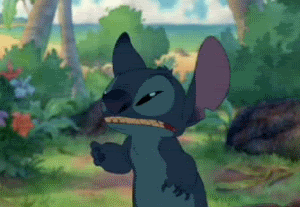
If not for TFOne's existence, I'd ask how you could mess up such a perfect woman.
Like she was her own character, her own history, EVERYTHING! And YOU COMBINED HER WITH AN EIGHT-LEGGED FEMME FATALE?!?!?!
Get the heck outta this franchise, whoever snorted cocaine and came up with that. You are a gutterbrained sack of potatoes, without the nutrients.
And then it's all just the crappy, postmodern "God isn't real, nothing has any actual meaning [evidenced by how Sparks hold no meaning beyond bringing what amounts to glorified mannequins to life], so do whatever you want without worrying about consequences, because they don't matter in our atheistic world!"
All this is disgusting and an insult to the franchise and to God, and the people who made it in the first place. I mean imagine how you'd feel if the character that is the legacy of your older brother was manhandled like Optimus was in the show. How happy would you be? And if not in TFA, you'd have to be heartbroken over what happened to him in Rise of the Beasts.
The only worthwhile thing out of that show was Blitzwing. He was actually well done, and he was the only good thing to come out of the show, at least after the Elite Guard (and even then, that was preceded by the end credits finally rolling.)
Everything else, especially the degradation of the Prime rank and Matrix of Leadership?

There's your door, take it before I throw you out.
6 notes
·
View notes
Text
"Wei WuXian! Just because... Sect Leader Jiang isn't here doesn't mean you can be so reckless!"
Wei Wuxian's voice was harsh, "Do you think that I wouldn't be reckless if he were here? If I wanted to kill someone, who could stop me, and who would dare stop me?!"
-- Ch. 72
Yeah why would anyone ever get the idea that WWX was a dangerous loose cannon who Jiang Cheng couldn't control?
He is of course justified for being angry in that scene - it's the scene in between Wen Qing finding him and him actually going to Qiongqi Path. But declaring that in front of a banquet of people right before he went off to find Wen Ning did actually give people a lot of ammunition in ch. 73:
Hearing this, Jiang Cheng's face was already quite dark. Jin GuangShan shook his head, "In an event as important as the Flower Banquet, he dared throw a fit right in front of you, leaving however he pleased. He even dared say something like 'I don't care about the sect leader Jiang WanYin at all!' Everyone who was there heard it with their own ears..."
While obviously that's not actually what WWX said at all, and just JGS doing JGS things, I had kind of categorized that in my mind as a wholecloth lie. Now looking back it's more like an extremely bad-faith mischaracterization but... the seed was in some ways planted by WWX and it makes sense that a lot of the people who were there that day might not have objected much to that characterization of the sentiment.
Obviously, a big part of it is mob mentality and the ways that truth doesn't particularly matter when they get on a roll. But I think it's more interesting and fun and messy that WWX really did have a habit of creating fertile ground for bad actors to use against him (even when he was right).
I do find it somewhat interesting how the juxtaposition of the Jiang motto/ideals/Way To Be that Wei Wuxian embodies - honest and unrestrained, do what is right even if it's impossible - can lead to a situation of winning the battle and losing the war. I've always found it particularly juicy that Jiang Cheng himself has to back away from those ideals and be more strategic, and re-reading these scenes does sort of cement my personal belief/interpretation that Jiang Cheng wasn't unjustified in the level of threat/danger he read into the things said at the emergency conference (as he elaborates on in the cave confrontation later in the chapter).
Just random musing that a little section of that Emergency Conference scene was actually a bit more nuanced than I'd remembered I suppose!
#mdzs thoughts#also big caveat that as someone going off translations#there very well could be aspects of the actual statements that are more obvious in the original that I am ignorant to#spicy necromaner things#yunmeng shuangjie things
29 notes
·
View notes
Text
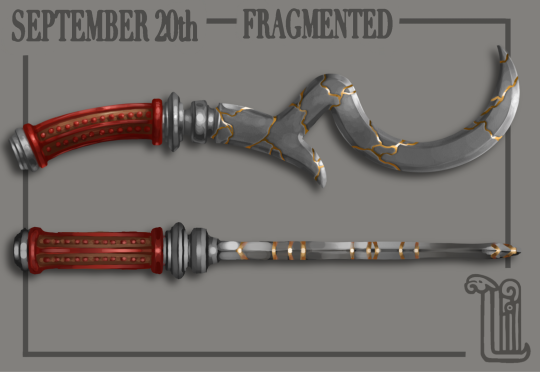
"Inducing Hunger in an object is difficult, but far from impossible."
Swordtember 20 - Fragmented
Hunger is typically a phenomenon reserved for humans—to want something inherently requires higher thought. Sure, some animals can align themselves with the heavens, but it is rare and unusual for them to do so. For an inanimate object to be imbued with Hunger is much more complicated and nearly never happens naturally.
The easiest method is to make an object out of a body form. Body forms maintain the power of their moons, and thus have an innate magic that—while not the most powerful—is easy to achieve and will last without salting. Such objects would include nacre-coated writing implements, or lenses made from sugar-glass.
One of the biggest downsides of objects made from body forms wholecloth is that their power is typically unfocused. In order to create a magical item with a specific effect, hopeful enchanters usually need to be more creative (and there are oh-so-many ways of being so).
Shattering is by far the most famous method of enchanting in the Chain thanks in no small part to the distinct look of the final product. The process usually involves several Starved drawing from several Powers, the most vital being Silken. To enchant an object, it first has to be broken—typically into tiny, tiny fragments, but with objects that need to be sturdy to function, the pieces can be larger. Next, a joint compound needs to be constructed; this is where the actual magic comes in. The compound is altered by the participants, whether that be making it lighter or in a constant state of Change or able to become an immediate object of obsession. Then, the compound (now Changed and/or Salted if necessary) is used to reconnect the pieces of the broken object. The final and most important step requires a person Hungry for Connection to tie the compound to the item, convincing both that they have and always will be part of the same whole. If done correctly, this should transmit the magic of the compound into the entire object, resulting in an enchantment.
8 notes
·
View notes
Note
Do you think there’s trouble if ppl use AI for like personal stuff? Say, that ghibli trend
Yeah I do, because I think all AI art is theft.
AI should be used as a tool to enhance, not create wholecloth. For example, I use it to help with translations. Emphasis on help. It's not sophisticated enough to do proper, real translations on its own, and it likely never will be. But for a language like Japanese, where there are no spaces between words, it's helpful to just have chatGPT put spaces in until I become more proficient in reading JP.
In terms of art, AI is useful for cleaning up artifacts on an image or for quickly removing a background or something. But you should never use AI to create something from nothing. That is theft, plain and simple.
2 notes
·
View notes
Text
Online Diary | November 17, 2024
Something hasn't been working for me when it comes to the God and the Goddess lately. I couldn't put my finger on it at first. It wasn't until after I'd done a determined makeover of the Goddess statue I have that I realized what the issue was. I don't connect with any of the popular conceptions of her floating around. This was a hard pill to swallow and something I've been avoiding for a while. The same goes for the God. I like the ritual structure of Wicca, I like the concept of worshipping two deities, a God and a Goddess, and I quite enjoyed learning about other people's favorite conception of the two-- but none of them really resonated with me.
This realization came around the time that I realized that I don't want to join a coven right now. In fact, these two things are deeply tied. I did find faces for the Goddess and the God, but they are not what other people use. Indeed, it might look like I made them entirely wholecloth to some folks, but they work for me. Call it divine inspiration. Due to this I really don't want to join any existing traditions because I'm honestly having so much fun with my solitary tradition now! It's weird because I was so stressed about finding the right coven, getting initiated, fitting in and devoting myself to the way they practice. But I think if I did that at this point in my life, I'd be miserable, and I don't see myself successfully convincing a bunch of people to start calling the Goddess a random name that came from the seedy depths of my brain, or indeed, believing that she's some eldritch creature representing the very fabric of our reality (I'm having a lot of fun with this conception of the Goddess, like lots of fun).
I seem to be doing fine now chugging along with the basic ritual structure provided by Wiccan classics, like Buckland's Complete Book of Witchcraft. Today, I was practicing casting a circle and creating sacred space. It was nice and I actually found myself getting into that mysterious state of flow where everything goes right and feels properly occult-y. It was also my first time using the names I have for the God and the Goddess. And it was the first time in a long time that I felt... I don't know... connected. It's sort of like I've been doing things wrong for a while, talking to a brick wall, experiencing very not enough satisfaction and feeling deeply frustrated by the whole ordeal. Then suddenly, I get the formula right, turn down the right path, and holy-shit-I'm-actually-feeling-the-presence-of-a-higher-power-right-now-it's-been-so-long. It's funny to imagine the gods watching me stubbornly muddle through my practice for the last few years, grumpy and obtuse, and then finally, finally getting it.
I also still like learning about how traditional Wiccan covens operate. I think it's interesting and cool, even if I myself do not resonate so much with all of their practices. I still do want to find a coven one day, but maybe not a traditional kind. I had a very non traditional one with my friends for a while that was more like a generalized pagan meet-up. We met by video chat every month and talked about magic and whatever we'd done with our various hodge podge of gods that month. It was nice and intimate! I'd be happy with that again-- maybe I can get those friends to revive our little group. That's an idea!
I've also found that Hekate has slowly rolled into my new concept of the Goddess. I've been devoted to her specifically for many years now, and I found myself getting pulled past her. In many ways, she's been subsumed into this Goddess in my head, but she's still there and I still treasure her guidance and her frankly dizzying number of roles in my life so far. I was afraid of this change for a long time. I felt that it was going against my commitments to Hekate. I've come to see things differently though! Change is a natural and normal part of life and I should not be afraid to let it happen.
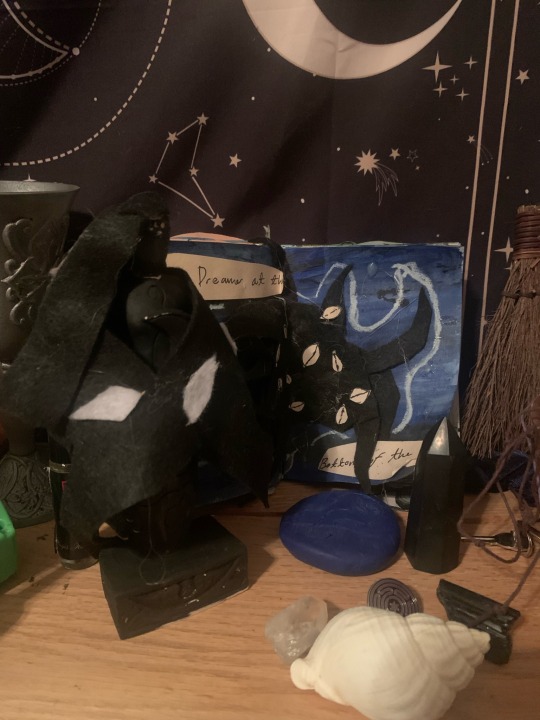
Pictured: the Goddess in all her eldritch glory (and yes I was a fan of H.P. Lovecraft growing up). The statue's details are a bit hard to define in this photograph, but it's a black statue with a black, tentacle shaped cloak with eyes on it. It also has a black headdress on. I added the cloak and headdress. It kinda reminds me of a nun's habit, which was unintentional but fun.
3 notes
·
View notes
Text
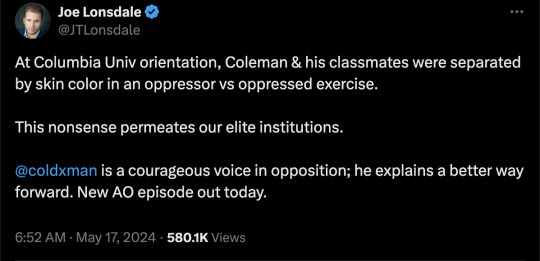
Coleman Hughes: When I enrolled at Columbia University, I think it was 2015, they had a student orientation. and they did this exercise where they had all the kids go to different corners of the room based on their race, white kids in one corner, black kids another corner, Hispanic, etc.
So right off the bat, I had to choose between black and Hispanic, which, you know, there's no really principled way for me to choose there.
Joe Lonsdale: You're kind of half each.
Hughes: I'm half-half, yeah. So, I think I chose black for whatever reason. The intent of this exercise was to somehow get, get us to reflect on racism, with the assumption that the students of color were victims of racism, and the white students had benefited from racism.
That was the framing of this exercise, but the actual effect was just to make me now sort of hyper aware of my race.
Lonsdale: And other people probably around you too.
Hughes: Yeah. Where I had gone into the room just, you know, hoping to meet my fellow classmates, learn their names, learn something about them, see if I have something in common, a basis for a friendship. Now I'm thinking, okay, so they now see me as the black guy and the victim of racism. That's how this is framing me.
And I thought that actually had the opposite of the intended effect of bringing us together.
==
Here's the dirty little secret: this isn't a freshman orientation or a "bringing us together" session. It's a religious induction ceremony. The point is to exploit a vulnerability or create one wholecloth, then introduce doctrine to resolve that vulnerability, and go from there. Next comes rituals to deepen commitment, and an "us vs them" mentality to separate the non-believers - who become proof the doctrine is true - from the faithful.
#Coleman Hughes#Joe Lonsdale#American Optimist#Columbia University#freshman orientation#antiracism#antiracism as religion#neoracism#woke#wokeness#cult of woke#wokeism#wokeness as religion#religion is a mental illness
4 notes
·
View notes
Text
TTRPGs, like videogames, are a medium where 'canvas', 'paper', 'brushes', 'paint', 'ink', 'pens', and 'pencils' have to be reinvented from scratch every fucking time one embarks on making one. Unlike videogames, where you can mod a game to get a different kind of 'feel' from it (see also insane DOOM total-conversion mods like Total Chaos which literally just make a different game) , there isn't really a way to do this 'well' in TTRPGs because TTRPGs are an immature medium despite being older than videogames.
The entire medium has been struggling under the yoke of Big Dragon Game™ and unfortunately for the history of the medium Big Dragon Game™ has been at the forefront of having lots of rules. This means when someone makes a game to challenge Big Dragon Game™, they think the fact that it has lots of rules is the problem, and also making lots of rules is hard! Better to make a minimum viable product and throw it out the door to see if that works than actually bother with a huge ruleset. That's what World of Darkness was, and it nearly killed Big Dragon Game™ until 3rd Edition blew it out of the water by having lots of rules and lots of answers for a lot of situations.
3rd Edition was 'good enough' to support an entire ecosystem of games until 2008 when WotC's dev team ruined everything with their hacked together attempt at a 4th edition, which despite being rules heavy had less rules for actual scenarios than 3rd edition. That's when the OSR really caught steam and people started making money by reprinting B/X as if that was something worth giving people money for.
People took the wrong lesson, thinking rules were the problem with 4th edition, rather than deliberately killing the OGL, making an antagonistic vaporware edition of the game, and also trying to 'de-Heinsoo' the math without telling your Monster Manual team about it leading to a massive mismatch between HP and damage. You know, the actual problems with 4th edition.
Now because the OSR was ascendant (as in made any noticeable amount of money at all) and people kept making their story games off to the side, we live in a post-rules discourse. The people outside the Big Dragon Game™ created a false consensus between OSR (reprinting maybe 1/10th of the rules those old-school dragon games had) and Indies (shoving everything into the PbtA and BitD systems) that rules were a failed system and that actually you shouldn't be doing rules at all unless they're strictly 'necessary to the narrative'.
But the problem is real rules have never been tried. Dragon Game 3rd Edition was just taking all those old school rules and making a coherent core system out of them.
I know real rules haven't been tried because I can't find stealth or disguise rules that aren't fucking binary to save my life. There's nothing to build on for 'rules' outside of rules for combat because there's barely been any development outside of combat since the era of 3rd edition.
It's fucking frustrating to craft systems that should have already existed out of wholecloth.
It is really flabbergasting how often and how hard I always end up having to go to bat for extremely significant and foundational elements of the TTRPG artform such as “adventure modules” and “rules.” It feels like if I were in a visual artist and I had to advocate for, like, pencils or the color green.
455 notes
·
View notes
Text
like im so obsessed with a new god instituting reincarnation because like either
1) reincarnation is real, but its the "you dont remember your past lives" deal, so by instituting it you're wiping out all the old souls to make way for the new system, inadvertantly "killing" uncountable people
2) reincarnation is real and it's the "you dont remember your past lives" deal, BUT you dont destroy old souls you just modify them, so you're taking those souls and giving them the ability to remember all old past lives
3) reincarnation isnt real already, so now you're INTRODUCING the idea into a world that already has a pre-set way of functioning. souls do exist already
4) reincarnation isnt a thing, you're introducing it, and souls DONT exist already
the horrors of 1) are pretty clear, you just killed a bunch of souls that were doing things naturally on their own.
2) makes you wonder, when do people become aware of their past lives? how many past lives do they remember? can you become a whole new person if you remember everything that once happened to you in another life? how many new people can ever exist again if everyone is carrying the baggage of 1000 lifetimes? if you become aware at 10, does the 10 year old you had formed into being with its own thoughts and personality simply cease to exist? in a way, didn't you just kill all 10 year olds and rewrite them with a new personality? can the human mind even cope with having that many memories?
3) if you're introducing the concept of souls reincarnating so that means there WAS some form of something, an afterlife or a way that the energy of the universe balanced itself or something, and now people DONT GET THAT. maybe the afterlife was all fire and brimstone for everyone and that would suck, but probably not. what if souls are a part of the way the universe functions in the same way energy and gravity and particles are, and by stopping them from rejoining the universe upon death you throw everything out of balance?
4) oh my GOD so if you come in later and invent souls wholecloth in order to do this you're, in my opinion, not actually creating natural "souls" but facsimilies of people that function as "souls" but dont actually save the person's "essence" upon their death. in the same way some people think that getting your brain copied into a computer upon death would leave behind a digital replica while your soul transcends to heaven, this is a copy of "you" that wasnt there to begin with and doesnt actually contain the Essence Of You, in my opinion. so you're taking virtual copies of people and superimposing them over babies that were GOING to form their own personalities but now never will and are in effect dead forever because you destroyed their ability to form their own Selves because you put a robot copy of a barista named mary over their brain, while mary is dead, and is now forced zombie-like to continue on forever, each iteration becoming a copy of a copy of a copy. the unique instance that is mary is gone forever, and everyone in the world is replaced by her and billions of others like her. the whole world is infected by a mad god who couldnt let the dead stay dead
1 note
·
View note
Text
I really, really, really like one of my supervising attorneys, she’s warm and a little bit crazy and the only one I feel comfortable talking politics and religion and other personal things with, even when we disagree, but---
honestly? if she tells me one more time that “things happen for a reason” and I’ll “look back on [this period of my life] having learned something valuable” I will not be held responsible for my actions.
#sometimes. existence is just fucking terrible.#we pull meaning out of chaos and dreck but the chaos and dreck is not purposeful it's not ordained or intended#the chaos and dreck is not something the overcome; it happens like star death or cancer or whatever other random cruelty exists#it just exists. it is the enduring wonderfulness of people that we pull something like coherence from it.#the coherence is fake and the triumph is created wholecloth from our brains but it's no less real by being fake#you get me?#anyway life is shit that's all you're getting the end#celestial emporium of benevolent knowledge
125 notes
·
View notes
Text
Don't mind me, just turning my lurking TLT blog into a full-time Animorphs meta factory since nobody I know personally has the 25-years-later brainrot I'm currently suffering.
Here's a parallel that fucks me up about Marco, specifically as it relates to his dynamic with Jake:
From Edriss, in Visser:
But I kept seeing a billowing white sail above me; feeling salt spray on my face, stinging my eyes; my hand on the tiller, the pressure of it against my palm; the sense that the boat itself was alive, endowed with life by the need of sky and sea to create some sort of union. Eva’s husband, my second husband, so to speak, was there, lying back, feet propped, a drink in one hand, a book he wasn’t reading in the other hand. And Marco, of course, climbing dangerously in the rigging, playing superhero.
From Jake, in #1 The Invasion:
So anyway, we crossed the road and headed into the abandoned construction site. ... Originally it was supposed to be this new shopping center. Now it was just all these half-finished buildings looking like a ghost town. There were huge piles of rusted steel beams; pyramids of giant concrete pipes; little mountains of dirt; deep pits that had filled up with black, muddy water; and a creaking, rusted construction crane that I had climbed once while Marco stayed below and told me I was being an idiot. (#1: The Invasion)
This is such a stark difference in behavior from Marco, and the whole arc happens before canon even starts, and I feel like it doesn't come up enough in discussions about him? Like, Edriss thinks of Marco as being too sweet & trusting to survive, and the books highlight the shift from that to his ruthless cynicism as a central tragedy of his character, and that is definitely a major part of the Marco equation. But there's also something in the shift from "fearlessly climbing in the rigging" to "calling your best friend an idiot for climbing a crane." Once upon a time, Marco was a fearless adventure-seeker. Then, too young, he learned what it really meant for somebody to die, and it destroyed that part of him.
My personal headcanon is that baby Marco was the kind of kid who could create adventure from wholecloth and regularly picked fights with bullies and probably also teachers on idealistic moral grounds, his miniscule size be damned (specifically, I like to imagine that he was very into the concept of knights and chivalry, although the superhero metaphor is more obvious). Following from this, I think the early years of his friendship with Jake were largely characterized by Marco ringleading and Jake backing him up. Marco was the one driving their adventures, picking their fights, and espousing their philosophical duty, while Jake followed in his wake, delighted to have such a dynamic person to orbit around, priding himself on his role as bodyguard. So their natural dynamic - the one that their friendship was built on, before losing Eva fundamentally changed who Marco is - was the opposite of what we see in the books.
Because Jake isn't a born leader. He doesn't actually want to be in charge. He doesn't have strong personal convictions or goals; he doesn't like making decisions; he's not comfortable weilding power (while Marco does and is). This is why Jake spends so much of the series looking for any excuse at all to abdicate, often calling for group votes or explicitly putting the burden of major decisions on individual teammates (especially Marco - "your mom; your call"). Ironically, this is part of what makes him a good leader: He can see everybody's perspective, he's willing to cede power and trust in expertise not his own, and his entire identity is a meditation on other people's values, helping him find middle grounds that nobody else can see because they're too set on their own paths.
Left to his own devices, though, Jake prefers to find people who he feels good about and then devote himself to them, adopting their worldviews wholesale so that he never has to wrestle with his own. In short, Jake wants a boss. And before the Animorphs, before Cassie, Jake had two people filling that slot: Tom and Marco. And Tom is his brother, so that's a default setting. Marco is the one he chose for himself. Marco's sense for adventure, his idealism, his willingness to pick a fight for a good cause - these are the things that made Jake choose him as a personal North star.
But then Marco lost his mom, and with her went his sense of the world as a just or safe place. Before, he thought of injustice as something temporary that you could defeat with a clever ruse or a brandished sword, and he believed that evil would always inevitably bend before a sufficiently determined good guy. Basically, he believed in the version of the world that exists in superhero stories: Sure, bad things happen, but you'll win in the end so long as you're in the right and you're clever about it.
For a long time, I made up stories about how my mom had survived. Maybe on a desert island or something. But I’m a realistic person, I guess. After a while I accepted it. (#5: The Predator)
No clever plan could bring Eva back, no matter how many stories he told himself about it, and accepting that meant accepting that anybody - including him - could just... die. Gone forever, for no reason at all. And even if they didn't die, they could disappear from him emotionally, like his father was actively in the process of doing, and no amount of fighting on his part could stop that, either. With Eva's death, Marco's world morphed into a senseless place full of random horrors, and Marco himself went from glory-seeking idealist to terrified realist. He's not telling himself superhero stories anymore; he sees them for the lies that they are.
And then Jake - a kid who specifically chose Marco largely because of Marco's idealism and sense of adventure - has to grapple with Marco's abandonment of those things, but with none of the personal emotional context attached. What does it mean to be eleven years old and watch your fearless leader suffer a complete crumbling of his worldview? And what does it mean for you, personally, when you've built your entire identity around following him, but he doesn't want to lead anymore?
I think it says a lot about Jake that he didn't abandon Marco. He easily could have found another optimistic, adventure-seeking person to follow instead, and indeed I think that's what Marco expected him to do. Afterall, if Marco's dad can more or less abandon him, it logically follows that Jake will probably do it, too. I think Marco's snark is largely a coping and deflection tactic, but on some level it's also an attempt to justify his continued role as Jake's best friend. He knows Jake picked him for the superhero-worshipping kid he used to be, and the only parts of that person he still has any connection to are his humor and his smarts. So he leans into constant clownery to reassure himself that he's still giving Jake the friend that he wants, and therefore Jake won't leave him. It gives him a sense of safety: As long as I'm smart and funny, Jake will have my back.
Jake’s my best friend. But he’s my best friend because I’m me, you know? Because I’m funny and smart and I’d back him up anytime, any place. I mean, what am I supposed to do? I’m me, Marco, not some touchy-feely, share-your-feelings-with-the-group kind of person. I don’t share feelings, I make people laugh. (#15 The Escape)
But of course Marco is never in danger of losing Jake at all, because Jake is an absolute loyalist where his people are concerned. You have to fuck up pretty bad for Jake to turn his back on you once you're in his inner circle. So Jake never even considered finding a new best friend; the job belongs to Marco, fullstop. Instead, he started trying to fill the void left by Marco's personality collapse himself, mirroring the traits that Marco used to have back to him, maybe in hope of sparking that part of Marco back to life. Jake idolizes superheroes. He intervenes with bullies. He flaunts danger to climb the construction crane.
But Marco can no longer see the crane as an adventure. He sees it as a death trap that could kill Jake at any second, and he doesn't feel safe until Jake is back on the ground, and he's angry that Jake can't understand that, so he insults him. Both because Marco can't express any feeling straightforwardly so his fear has to come out sideways, but also because Jake is a mirror of who Marco used to be, and on some level Marco hates that naive little kid just because he doesn't get to be him anymore.
By the time we meet them in canon, Marco and Jake are two years into this new dynamic. Jake is occupying the leadership role full time while still modeling himself after the way Marco used to occupy it (with a dash of Tom, because little brother syndrome), occasionally succeeding at drawing out bits of the old Marco in the form of harebrained schemes. Meanwhile, Marco is intensely aware that he is no longer the person Jake wants him to be, and he vascilates wildly between regret/fear (because he might lose Jake if he can't retain some scrap of that person) and contempt (because that version of him was a naive child who believed in superheroes instead of death, like an idiot), and both of these come out in his treatment of Jake. They love each other absolutely, but there is also a disconnect that they don't know how to talk about.
And then the universe is like, lol, let's give these two boys with a specifically superhero-flavored interpersonal power struggle actual superpowers, plus a team to lead in a mandate to save the world.
It's also worth noting that in #50, when Jake has fully given up and is actively trying to abdicate all responsibility for leadership, he tells Cassie that he's only leader because Marco said he was:
“Marco can be in charge,” he said helplessly. Again he pulled his hand away. This time I let him go. “He’s smarter than I am. Or Tobias. Or Ax. Or you. Rachel. Anyone. Anyone but me. You know why I was in charge in the first place, Cassie? Because once upon a time, a long time ago, Marco said I was.” “Jake, that’s not the whole truth …” “Well, now my term of office is over,” he continued bitterly. “So how about for once you guys figure things out and tell me what to do.” (#50 The Ultimate)
But Marco didn't say he was, at least not until after that consensus had already been reached by the others (at least, I can't find it in the pages of the early books - somebody please point me to the passage if it does exist!). If anybody, it was Tobias who waved the fearless leader wand over Jake. But Jake remembers it being Marco, because Jake's whole life is colored by Marco's abdication of leadership in their interpersonal relationship. Everybody else sees Jake as being in charge (and most of them put Rachel second in line), but Jake sees himself as a placeholder for Marco, ready to step aside just as soon as Marco tells him to. But Marco never will.
Anyway, that's my headcanon about what those two lines mean for the Marco/Jake dynamic.
#marco animorphs#marco and jake#animorphs meta#animorphs#what I'm saying is that Jake Berenson is a sub#he's a bratty sub too#Marco come and get your boy#also something something Jake fell for Cassie because she embodies all the sweetness and idealism that he misses in Marco#I ship jakemarco but in postcanon because they gotta defuse their not-it power struggle over who's in charge first#and an ongoing war effort is not conducive to constructive conversations about interpersonal hierarchical command structures#jake berenson
71 notes
·
View notes
Text
So the new trailer for Spider-Man: Across the Spider-Verse just came out, and because I'm a fucking enormous nerd who loves Spider-Man, I'm going to go through that big zooming shot with all the Spider-People and try to figure out where they're all from. If I can't figure it out and you have a better guess, let me know and we can figure it out together.
Even blown up on my 75 inch monitor, these first ones are hard to see, especially because of internet video compression, but I can kind of make out the color scheme of a suit that a version of Spider-Man who was in the Avengers wore. He was just called The Spider and he was kind of an asshole.
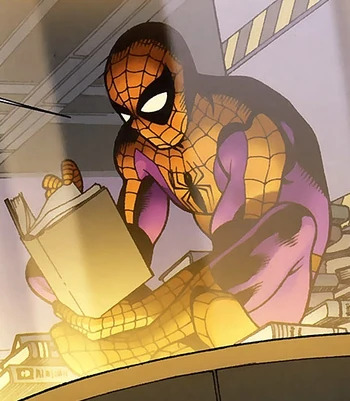
Some of these I can't find anything about even though they're pretty distinctive. I might have to go back and read through my Spider-Verse comics to see if any of them made appearances there. For instance, this guy in the red with the glowing blue chest symbol:
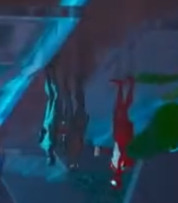
The one facing the camera could be a 2099 suit variant but the last one has basically no visible distinguishing features so it's impossible to tell. I also have no idea who this purple guy is. Could be a design based off the Prowler, especially ItSV's version of the Prowler.
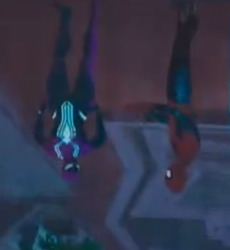
The guy he's talking to though appears to be wearing Spider-Man's classic comic book suit. This one seems even closer to the original design than Peter B's suit, which is based off the more modern comic redesigns. This is the OG.
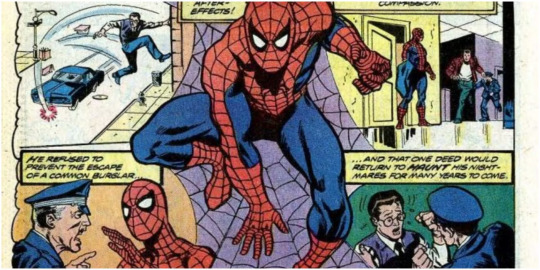
Again, I can't figure out who the big guy is here but the other one might be Ben Reilly:
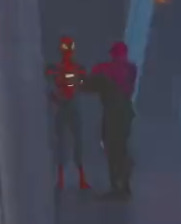
Specifically Ben Reilly wearing an advanced suit given to him by the Beyond Corporation, which isn't really a corporation per se, more a collection of entities that exist between universes and decided to start multiversal capitalism. Based on the weird extradimensional corporate aesthetics of the film, Beyond Corporation or at least the Beyonders might have something to do with the plot of Across the Spider-Verse.
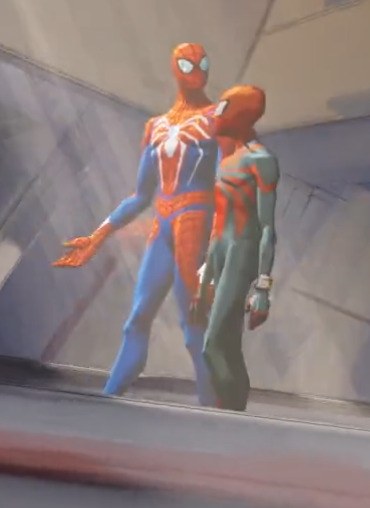
There's Insomniac Spider-Man chatting it up with Superior Spider-Man, who was Otto Octavius's mind in the body of Peter Parker. Not an alternate universe character, by the way. This happened in the main comic series. Spider-Man was just being possessed by Doc Ock for a while.
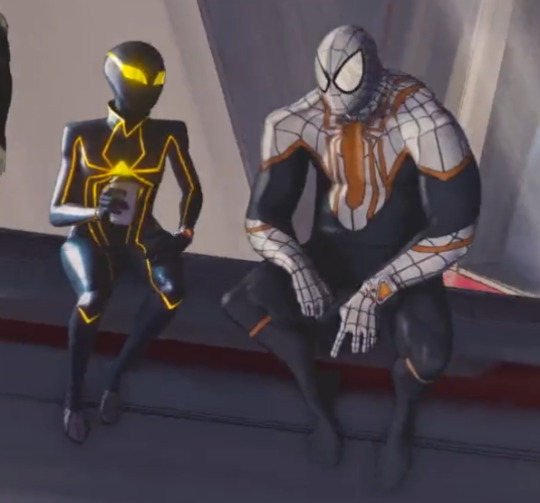
Here's the Mk II Armor suit hanging out with another guy I can't place. Spider-Man's Mk II armor was created by Horizon Labs to help Peter out when he lost his Spider-Sense for a little while. If you can't dodge bullets anymore, might as well get a bulletproof suit.
There are three others on this bridge I can't place. They all look to be women, and they've got color schemes that have been on Spider-Man suits before, but in different patterns, so I'm a little stumped. I imagine not all of these are going to be references, and some are just created from wholecloth, but if you can figure it out, let me know!
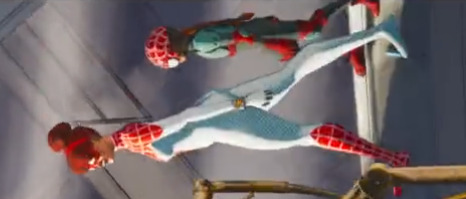
This is probably Mary Jane and Mayday Parker, although I'm not familiar with the suits. Mary Jane has gotten spider powers in a few universes, and when Peter and MJ have a daughter in most universes, her name is Mayday, and she usually has spider powers.
Which is a lot better than that one universe where MJ got cancer and died because Peter had radioactive cum. I'm not kidding, that's a real thing that happened in an official comic series.
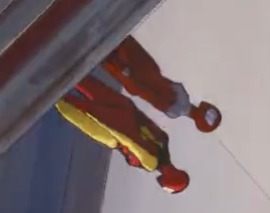
The red and white is another Scarlet Spider variant suit. Not sure about the red and yellow next to him.
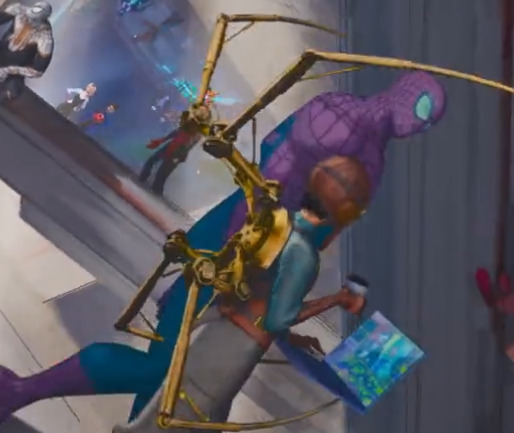
This one with the clockwork arms is Lady Spider. She appeared a few times in the latest Spider-Verse event and comes from a cool steampunk universe. She has no powers, just her spider arms and web shooters, and is technically an alternate universe version of Aunt May.
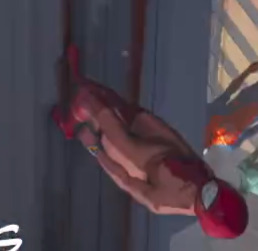
This guy looks... naked??
It could be Savage Spider-Man? Or Kraven the Hunter Spider? But it looks like he's not wearing pants, so it might just be a weird skin-toned suit. I dunno.
Anyway here's Spider-Clan from the Spider-Man manga dabbing
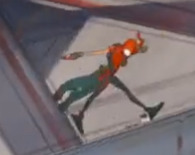
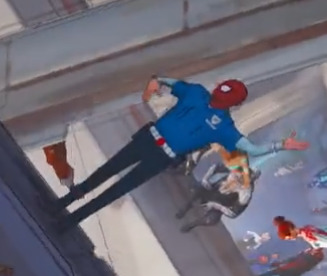
This guy's pretty prominent. I think he's supposed to be a reference but I'm not sure to what. It could be Spider-Cop, but he's missing his hat, sunglasses and mustache.
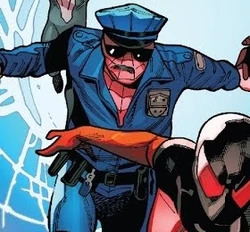
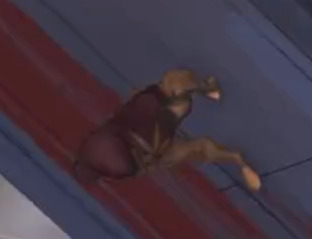
This might be the original Iron Spider suit from the comics. Tony Stark made it for him after he came back from being dead for the, like, 3rd time.
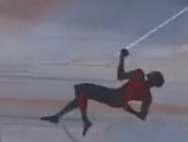
This looks like Miles Morales's PS4 costume, but it swings by pretty fast, so it's hard to make out much detail.
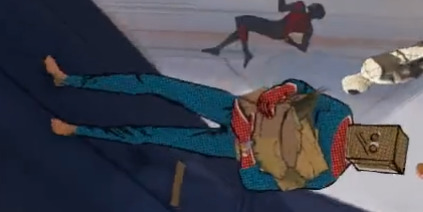
Bombastic Bag Man! This is a little different to his appearance in the comics, but there have been a couple times Peter needed a spare suit on short notice and had to borrow one from the Fantastic Four. Their suits don't have masks, though, so he wore a bag on his head instead.
The first iteration also had a "Kick Me!" sign on the back, because the Human Torch thought it would be funny.
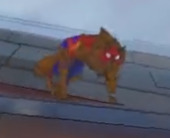
Here's werewolf Spider-Man in the back. During a crossover event, Ash from the Evil Dead comics ended up going to a few different universes, one of which started the Marvel Zombies series (which is actually a pretty good series). Another one he went to had a bunch of superheroes turning into werewolves, and Spider-Man was one of them.
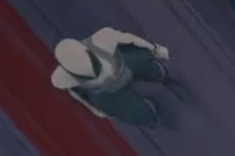
This looks like a suit Spider-Man wore when he was part of the Future Foundation; a version of the Fantastic Four that formed when the Human Torch died.
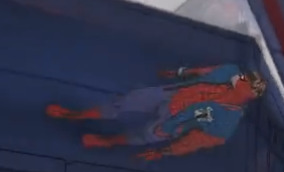
This looks similar to Spider-Punk. He's got the jacket and the pants, but instead of his mohawk spikes, he's got some kind of camo baseball cap or something, and what looks like a face mask of some sort.
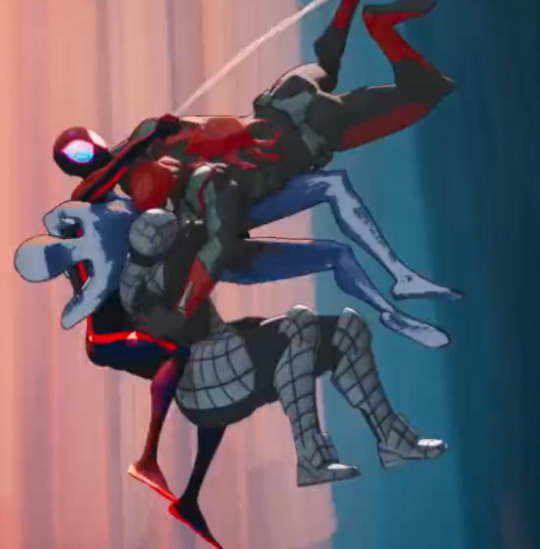
In this shot, Miles is fighting with the Mk I armor and something similar to the Mk III armor, although it's definitely different. The lady with six arms is a mystery to me.
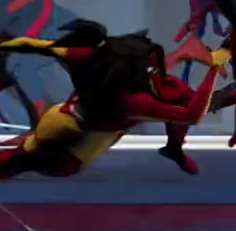
Yo, is that Jessica Drew Spider-Woman? Jess Drew gets overlooked a lot despite being the first Spider-Woman. I hope she gets some kind of role in this movie.
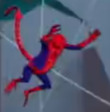
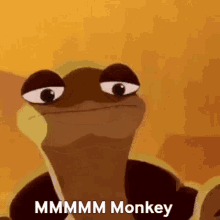
Spider-Monkey is from the Marvel Apes universe. Yeah, there's a Marvel Apes universe.
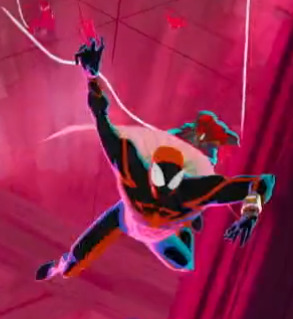
I'm getting tired but I remember this one from somewhere. A cartoon maybe? I think I remember seeing a Spider-Man suit with a cape as a kid and thinking it was dumb because Spider-Man doesn't wear a cape.
Anyway that's all I could find aside from the main characters. Again, if you can track down any other references let me know. I'm too much of a nerd to let this go.
62 notes
·
View notes